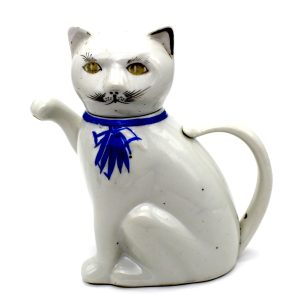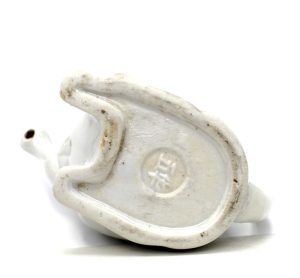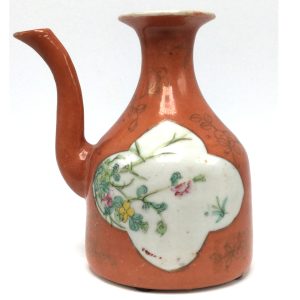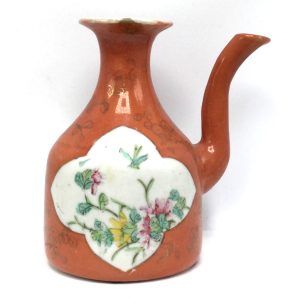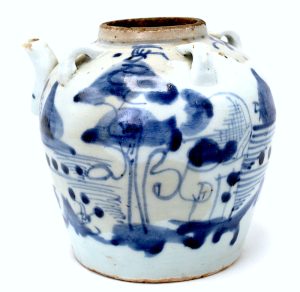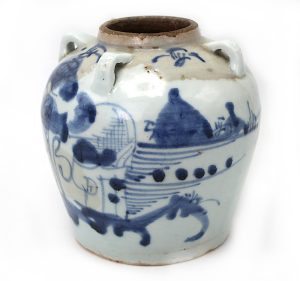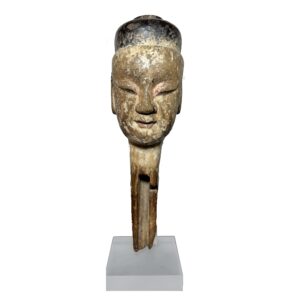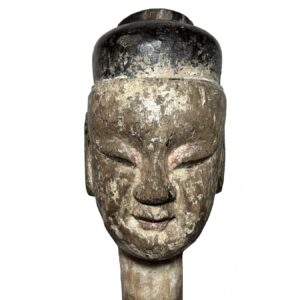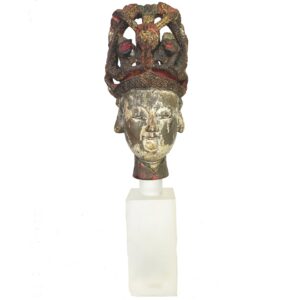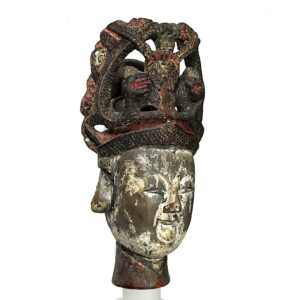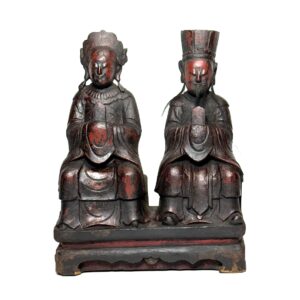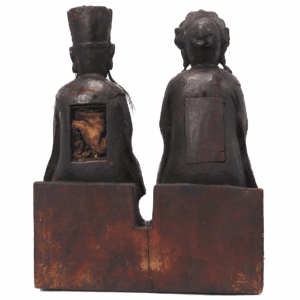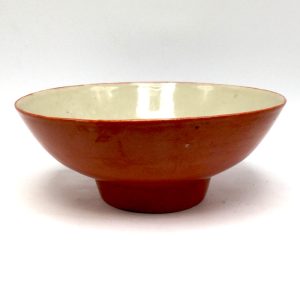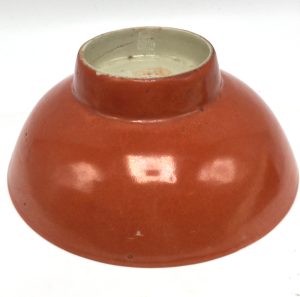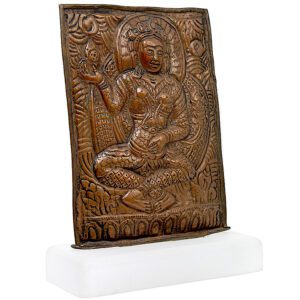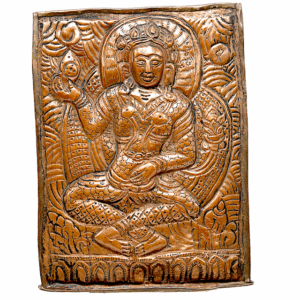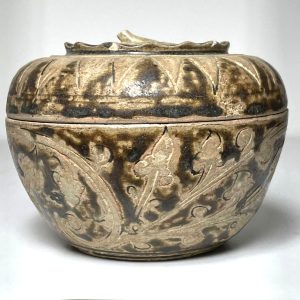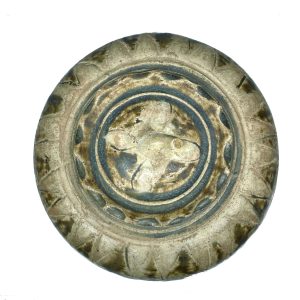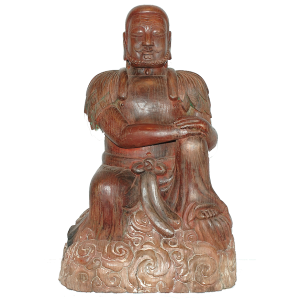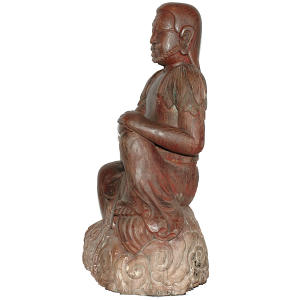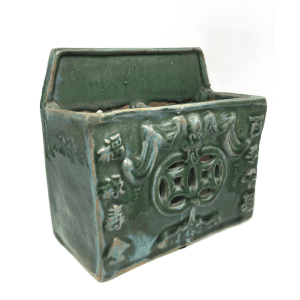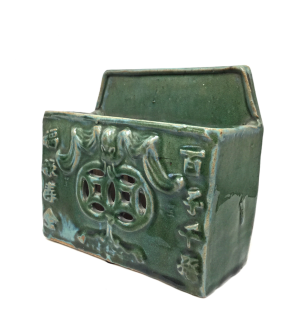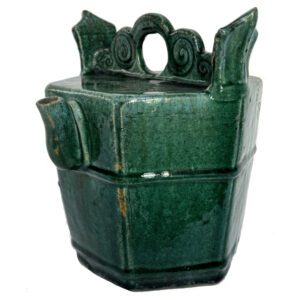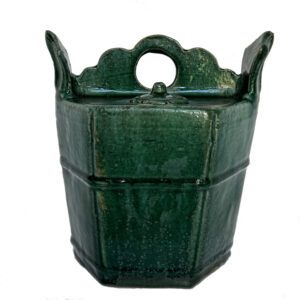Showing 61–72 of 164 results
-
Sale!


$145.00 Original price was: $145.00.$125.00Current price is: $125.00.
Ht: 6.25” W: 5.5” D: 3.25” | FREE SHIPPING WITHIN CONTINENTAL U.S.
The Chinese characters within a circled seal in the mold on the bottom indicate this teapot is an antique. As the thin ribbon blue collar as wishes for long life, it is a perfect birthday gift. Recommended for decorative use only.
-
Sale!


$235.00 Original price was: $235.00.$195.00Current price is: $195.00.
H: 4.875″ W: 4.5″ D: 3.25″ | FREE SHIPPING WITHIN CONtINENTAL U.S.
Elegantly shaped porcelain ewer with graceful spout, saffron-colored glaze, quatrefoil panels and hand-painted floral designs within a gold frame with sinuous gold leaf vines.
-
Sale!


$145.00 Original price was: $145.00.$105.00Current price is: $105.00.
H: 5” W: 5.25” D: 4.5” | FREE SHIPPING within continental US.
Blue and white ceramics like spouted jar with four loops, were used in home kitchens and restaurants to hold oil, sauces, soy or other liquids. Decorated with country scene in a landscape with by tall trees.
-
Sale!


$495.00 Original price was: $495.00.$395.00Current price is: $395.00.
Ht: 22.25” W: 7.25” D: 5” | FREE SHIPPING WITHIN CONTINENTAL U.S.
This detailed male puppet head with a calm expression, round bun and half-smile was very versatile, used in religious or secular performances. Changing costumes and headgear, it could have been a Buddhist, Taoist or Popular Religion figure or deity or non religious character.
-
Sale!


$785.00 Original price was: $785.00.$495.00Current price is: $495.00.
Ht: 17” W: 4.25” D: 4.5” | FREE SHIPPING WITHIN CONTINENTAL U.S.
Very rare depiction of Queen Mother of the West puppet head wearing elaborate headdress with outstretched tortoise legs atop a phoenix, reflecting early shamanism rites of turtle shell divination. Mounted on acrylic base.
-
Sale!


$995.00 Original price was: $995.00.$695.00Current price is: $695.00.
H: 10″ W: 7.75″ D: 8.25″ | FREE SHIPPING WITHIN CONTINENTAL U.S.
Rare single image of Kitchen God and wife, indicating their close/lasting relationship as family’s protectors. Detailed elaborate officials’ robes, headgear. Individually portrayed holding hu tablets like those held by high court officials or Taoist priests.
-
Sale!


$135.00 Original price was: $135.00.$110.00Current price is: $110.00.
H: 2.5” Dia: 5.75” | FREE SHIPPING WITHIN CONTINENTAL U.S.
Beautifully shaped footed porcelain bowl, thinly crafted with a coral saffron glaze on the outside on a deep foot. Fading red stamped seal of an unknown kiln on bottom. Likely from the Tongzhi Period 1862-1874.
-
Sale!


$250.00 Original price was: $250.00.$165.00Current price is: $165.00.
H: 7.5″ W: 5.75 D: 2.5″ | FREE SHIPPING WITHIN CONTINENTAL U.S.
Copper alloy repoussé votive plaque of Vishnu surrounded with head and body aureoles. Symbols of his power as Universe’s Protector include a conch shell, his crown and lotus leaves symbolizing purity, truth, and unfolding of creation.
-
Sale!


$385.00 Original price was: $385.00.$325.00Current price is: $325.00.
Ht: 3.375” Dia: 4.625” | FREE SHIPPING within continental U.S.
Sawankhalok elegant mangosteen shape stoneware lidded bowl with raised calyx, cream and brown glazes, incised floral and geometric designs to store spices, cosmetics, betel nuts and medicine.
-
Sale!


$4,600.00 Original price was: $4,600.00.$3,900.00Current price is: $3,900.00.
H: 30.5″ W: 19.25″ D: 11.75 | CALL 213-568-3030 OR EMAIL [email protected] FOR SHIPPING
Masterful carving of Shen Nong, revered hero and reputed father of both Natural Medicine and Agriculture. Benevolent, sitting on cloud, leaves on shoulders. One of 3 sovereigns who contributed to well-being of humanity. Especially fitting for health care, pharmaceutical or agricultural professional or associated with tea.
-
Sale!


$185.00 Original price was: $185.00.$135.00Current price is: $135.00.
H: 7.125″ W: 8.375″ D: 3.75″ | FREE SHIPPING WITHIN CONTINENTAL U.S.
Shiwan 2 part chopsticks holder with top holes for hanging and bottom ones for drainage. Chopsticks were wedding gifts from mothers to daughters with auspicious wishes: sons as soon as possible, blessing for prosperity, happiness and fertility, life-giving rain and abundance.
-
Sale!


$395.00 Original price was: $395.00.$270.00Current price is: $270.00.
H: 9″ W: 8.375″ D: 5.5″ | free shipping within continental u.s.
Apple green glazed teapot typical of Shiwan kiln pottery known for its brilliant flambé glazes in the 18-19th century. Hexagonal shape with yoked rounded handle with spiral decorations that adds a decorative touch.
End of content
End of content

